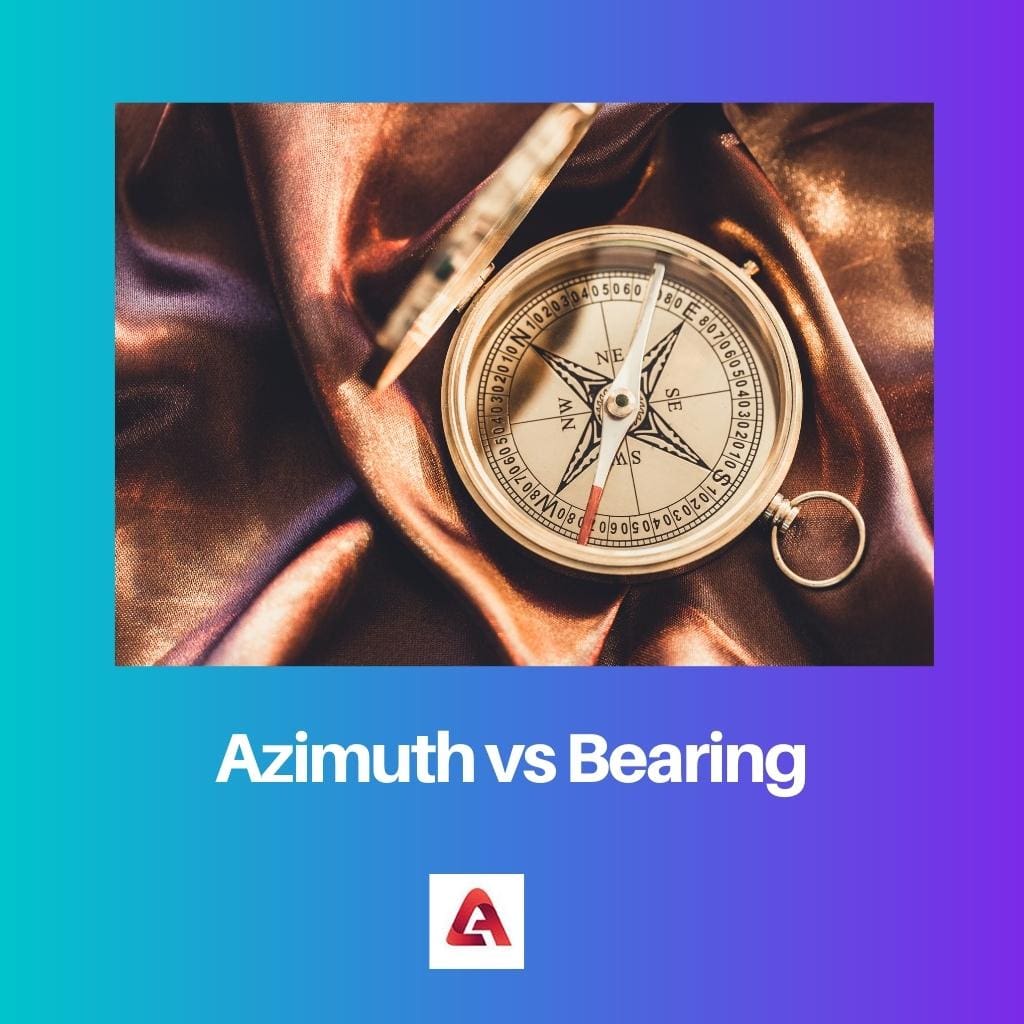Azimuth and Bearings are kinds of angles that are used in surveying. Azimuth is a kind of bearing. Both of them are different, and the measurement of the angle differs in both cases. Both have a different range of values.
There are many differences between Azimuth and Bearing. Azimuth uses numerical representation. Bearing uses an alphanumeric presentation for its values.
Key Takeaways
- Azimuth is the angle between the north direction and the point of interest, while the bearing is the angle between the north direction and the direction in which an object is located.
- Azimuth is measured in degrees, while the bearing is measured in degrees or mils.
- Azimuth is commonly used in land navigation and surveying, while the bearing is used in marine and aviation navigation.
Azimuth vs Bearing
Azimuth refers to the angle between the observer’s direction of reference and the direction of the object of interest, measured clockwise from north. Bearing refers to the angle between the observer’s direction of reference and the direction of the object of interest, measured clockwise.

Azimuth is a type of bearing. Azimuth takes a set of measurements from North or South. It is also one type of bearing. It is also known as the whole circle-bearing system. It is also used in many fields, like surveying.
It starts measuring in the North direction. Astronomers and the military tend to use Azimuths from the South direction.
Bearing is an angle that is the measurement between the reference meridian and the given line. The representation of Bearing is very much different from the Azimuth. It starts from North or South, then the degree, and then east or west.
The degree is always less than 360 degrees. The magnetic meridian is calculated using the needle of the compass.
Comparison Table
| Parameters of Comparison | Azimuth | Bearing |
|---|---|---|
| Angle Range | 0 to 360 degrees | 0 to 90 degrees |
| Representation | Numerical | Alphanumerical |
| Direction of Measurement | Clockwise | Anticlockwise |
| Rule | set of points from North or South | Angles in North or South |
| Usage | Horizontal Plane measurement | Angle Measurement |
| Applications | Delicate Surveys | Specific purpose surveys |
What is Azimuth?
Azimuth has its origin in the Arabic word, which means direction. It refers to horizontal angles. These angles measurement begin from the reference median. This measurement takes place in a clockwise direction. These are mostly used in doing surveys.
It helps in compass and plane surveying. The measurement begins from the North direction. Astronomers and the Military begin their measurement from South Direction.
The lines always have a range of values from 0 to 360 degrees. There can be many types of Azimuths. They are geodetic, magnetic or astronomic.
It is a rule that the reference median should be stated at the beginning of the survey. This is done to avoid mistakes in the measurement. The measurement is done by forwarding azimuth and a backward azimuth.
The forward azimuth declares the forward direction, but the backward Azimuth refers to the reverse direction. It is also used in many other areas, such as control surveys, topographic surveys, and others.
The angle is the measure of deviation from North or South. This is the horizontal angle measurement from a fixed point to the direction of the object. Celestial navigation uses Azimuth for all the angle measurements.

What is Bearing?
Bearing refers to an acute angle. The angle is between the reference meridian and the given line. The measurement begins from North or South and then goes towards East or West. The angle will always be less than 360 degrees. The angle is represented by an alphanumeric.
There are many types of bearing available. A local magnetic meridian is used to measure a magnetic bearing. A grid meridian is considered for the measurement of grid bearing, and a geodetic meridian for geodetic bearing.
The needle of the compass is used for measuring the magnetic meridian. Bearing is also written in mils or degrees. This is also used for general purposes. Bearing is used for angle measurement. This is the same as Azimuth.
Bearing is used for specific purposes of surveys. They are represented by cardinal directions. It starts with North or South and then the angle and at last ends with East or West. This East or West denotes the quadrant. Bearing is always done with respect to North or South angle lines.
The measurements always occur clockwise in North-East and South-West, representing the first and third quadrants. It takes anticlockwise measurements in North-West and South-East directions which are the second and fourth quadrants.
Main Differences Between Azimuth and Bearing
- Azimuth measures angle from 0 to 360 degrees, whereas Bearing measures angle from 0 to 90 degrees.
- Azimuth is denoted through numerical value, but Bearing is denoted through alphanumeric values.
- Azimuth measures clockwise, but Bearing can measure in both directions, either clockwise or anticlockwise.
- Azimuth takes a set of measurements from North or South, whereas Bearing measures angles from North or South.
- Azimuth is used for horizontal plane measurement, but Bearing is used for angle measurement.
- Azimuth is used for specific important, delicate surveys, whereas Bearing is used for specific purpose applications.





